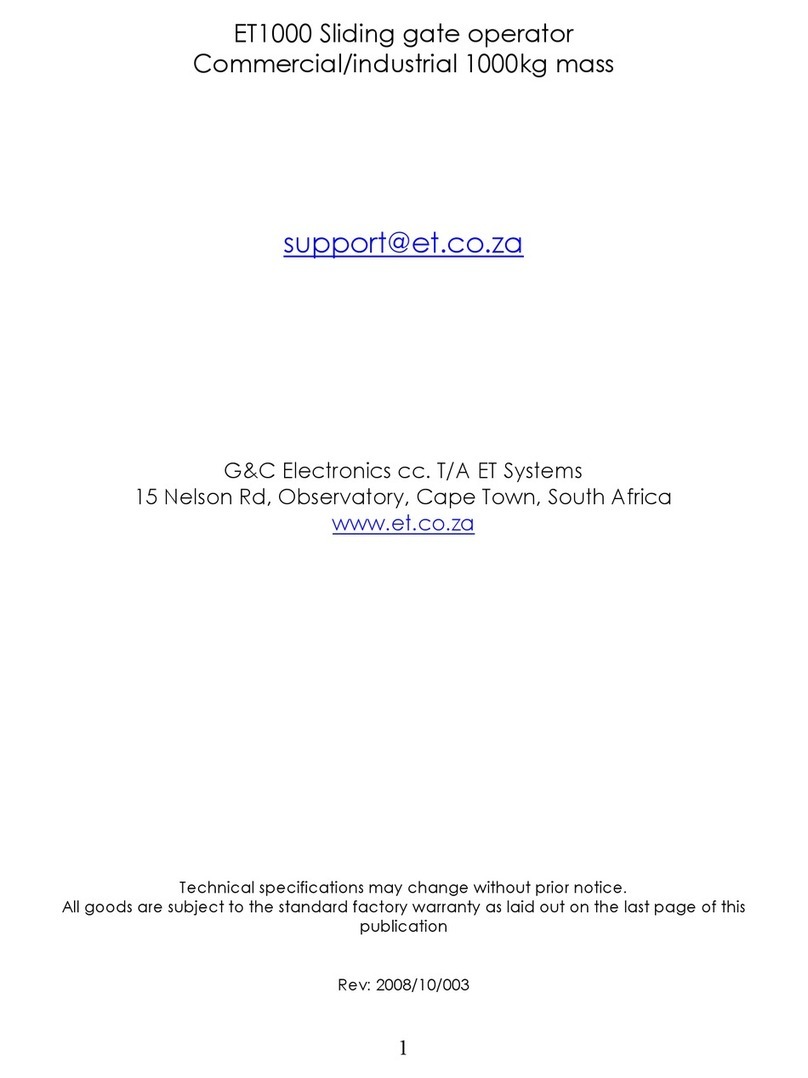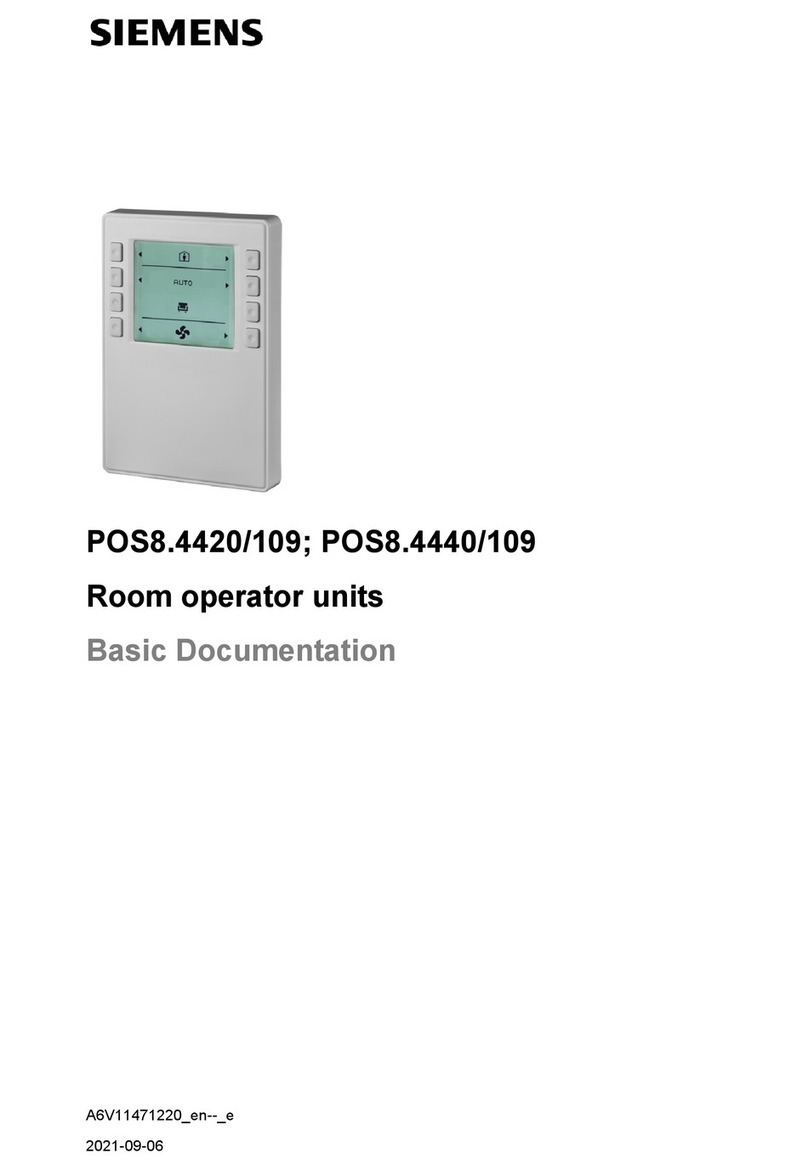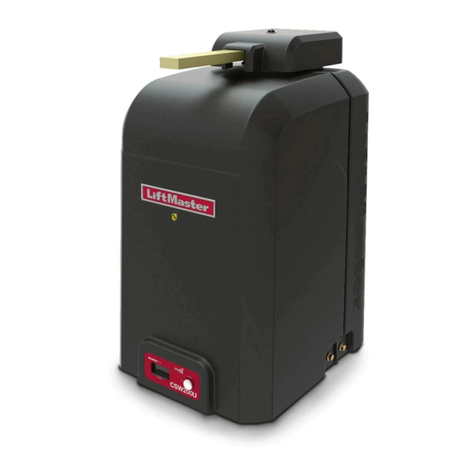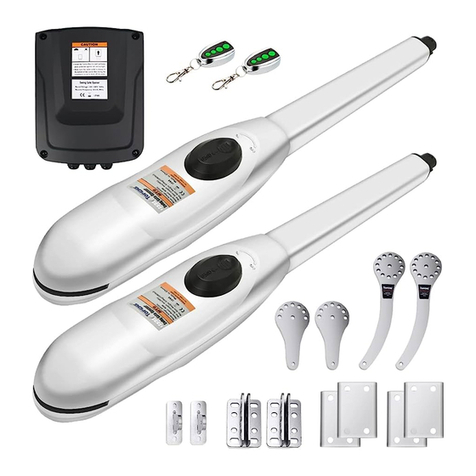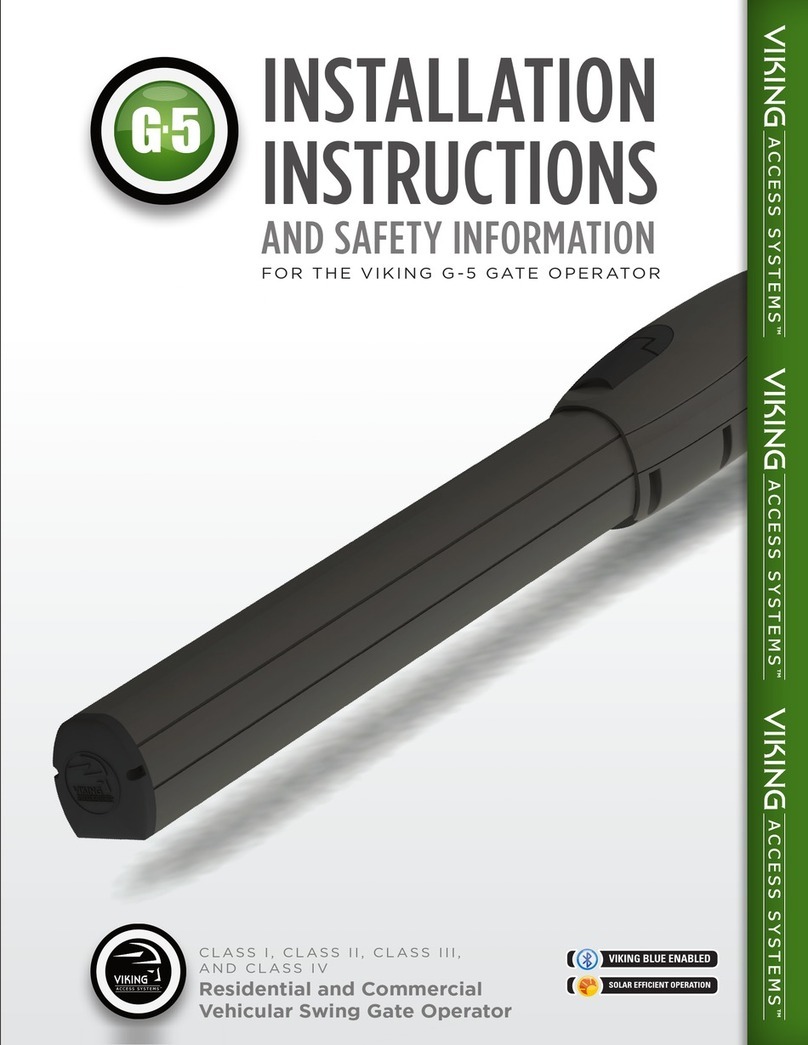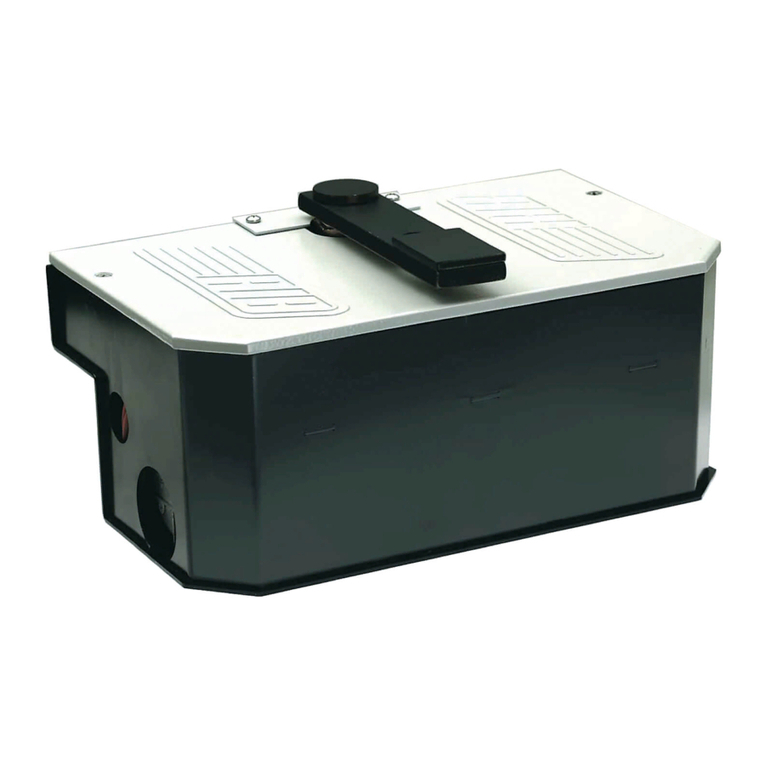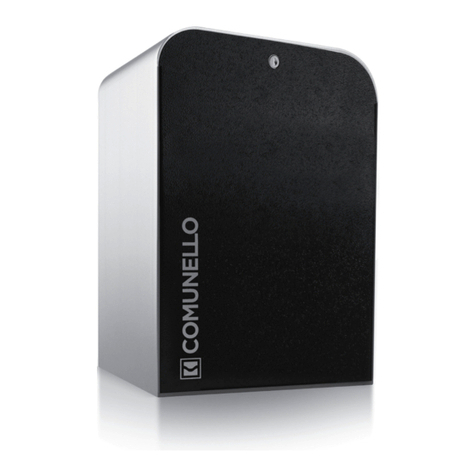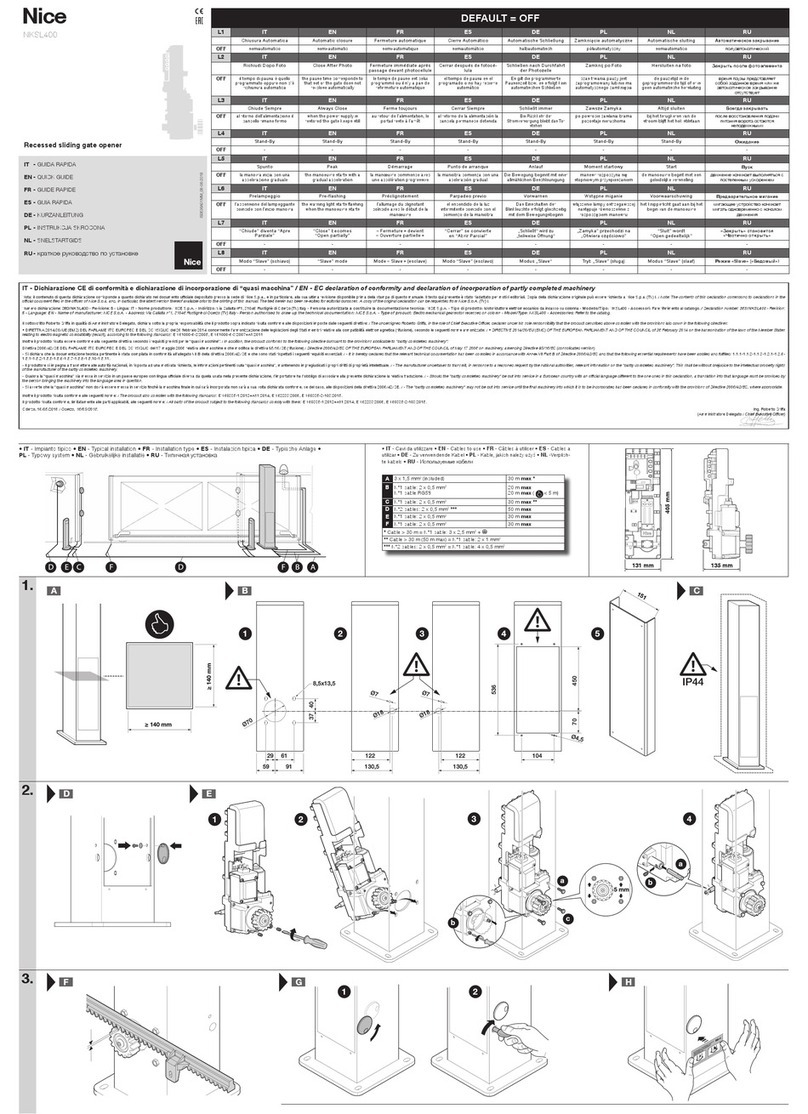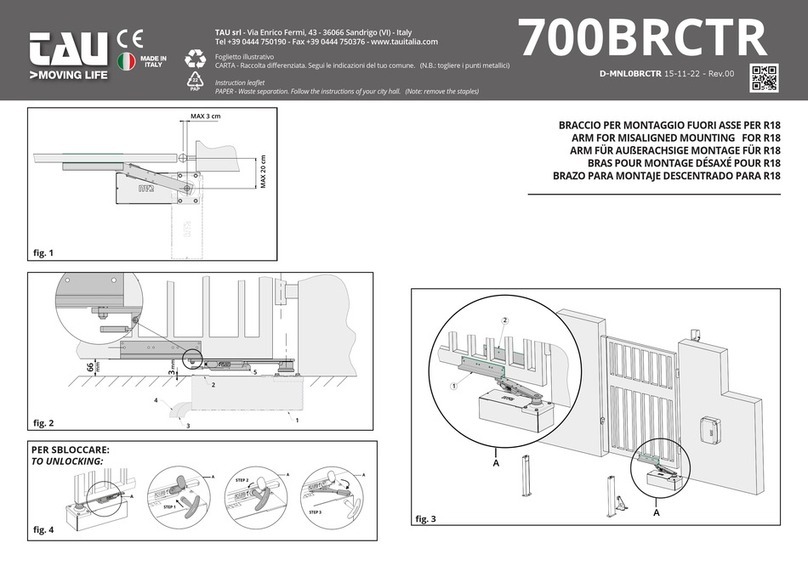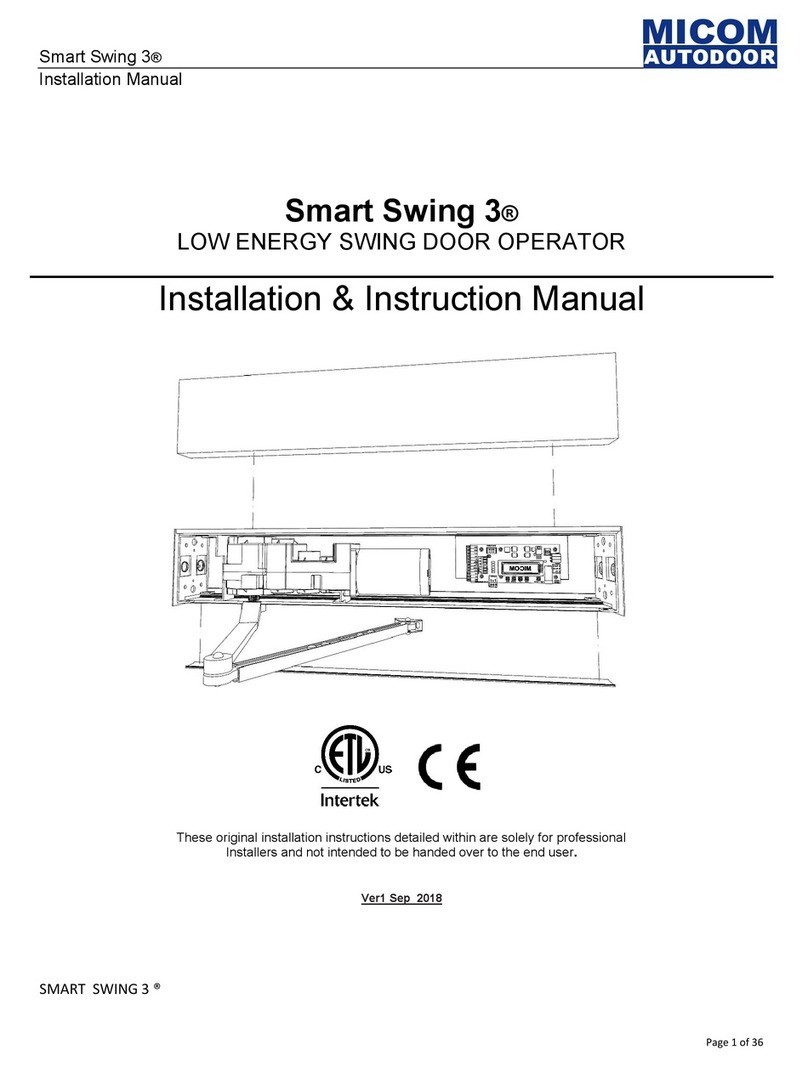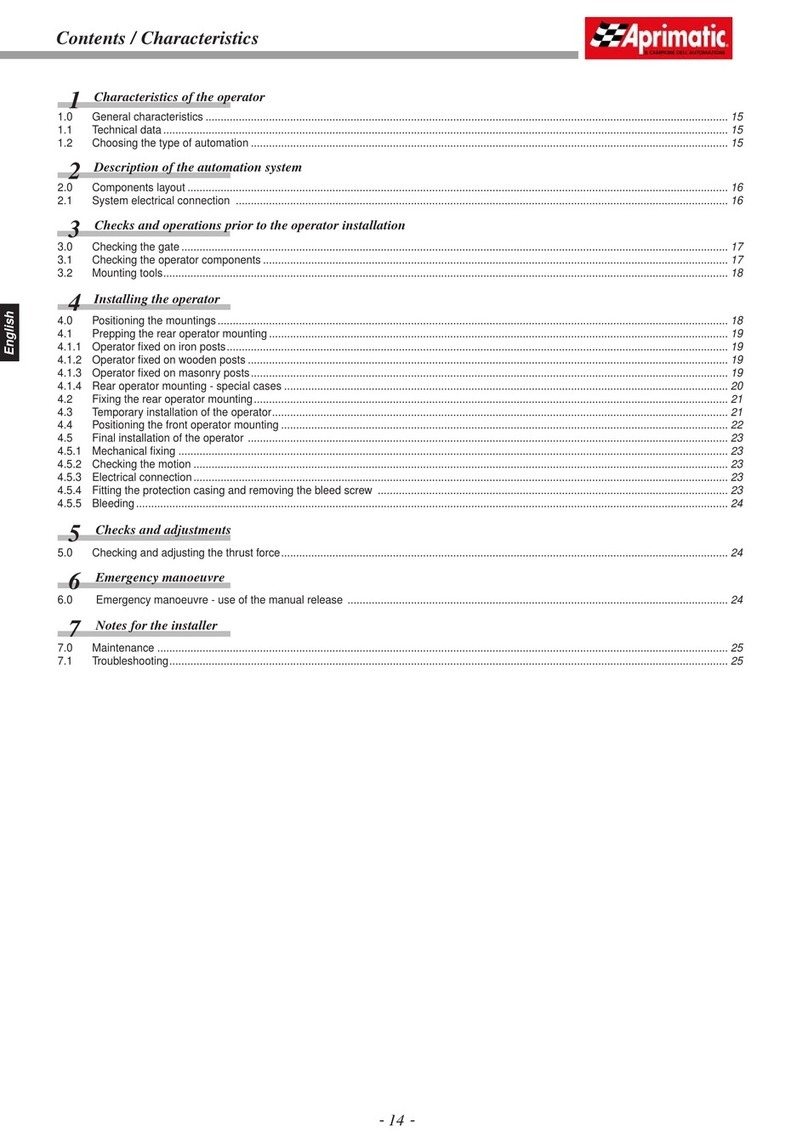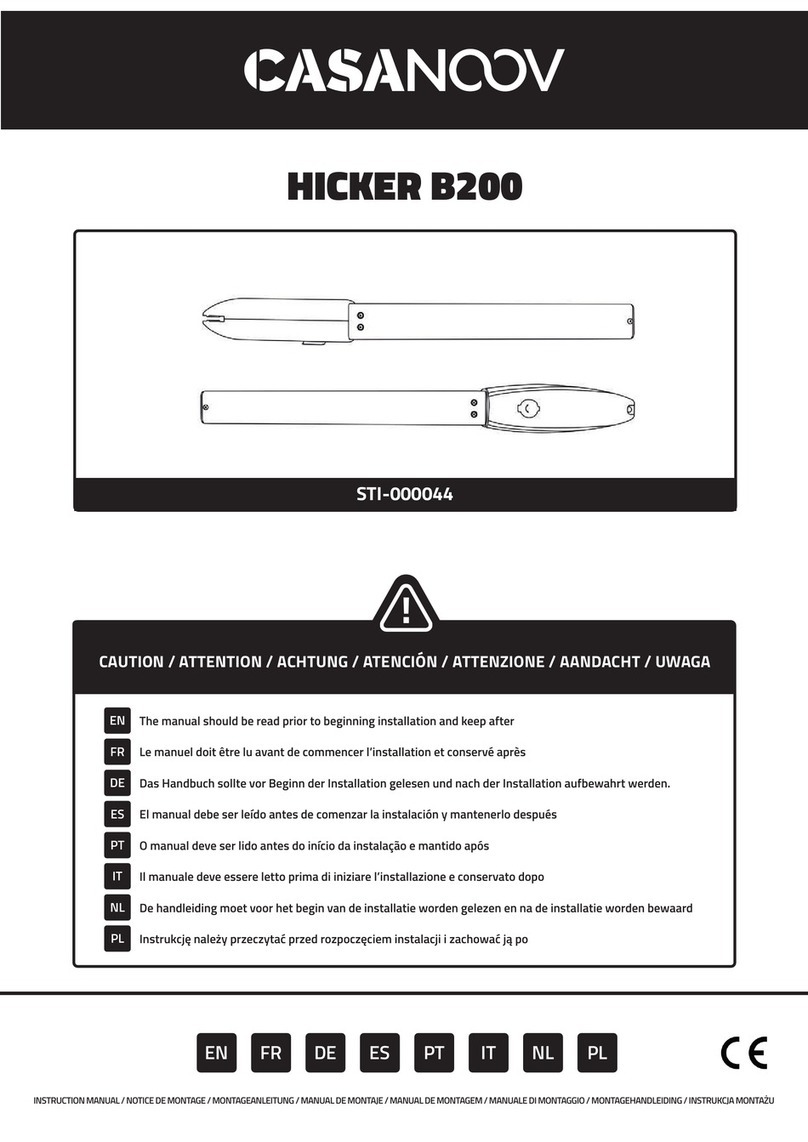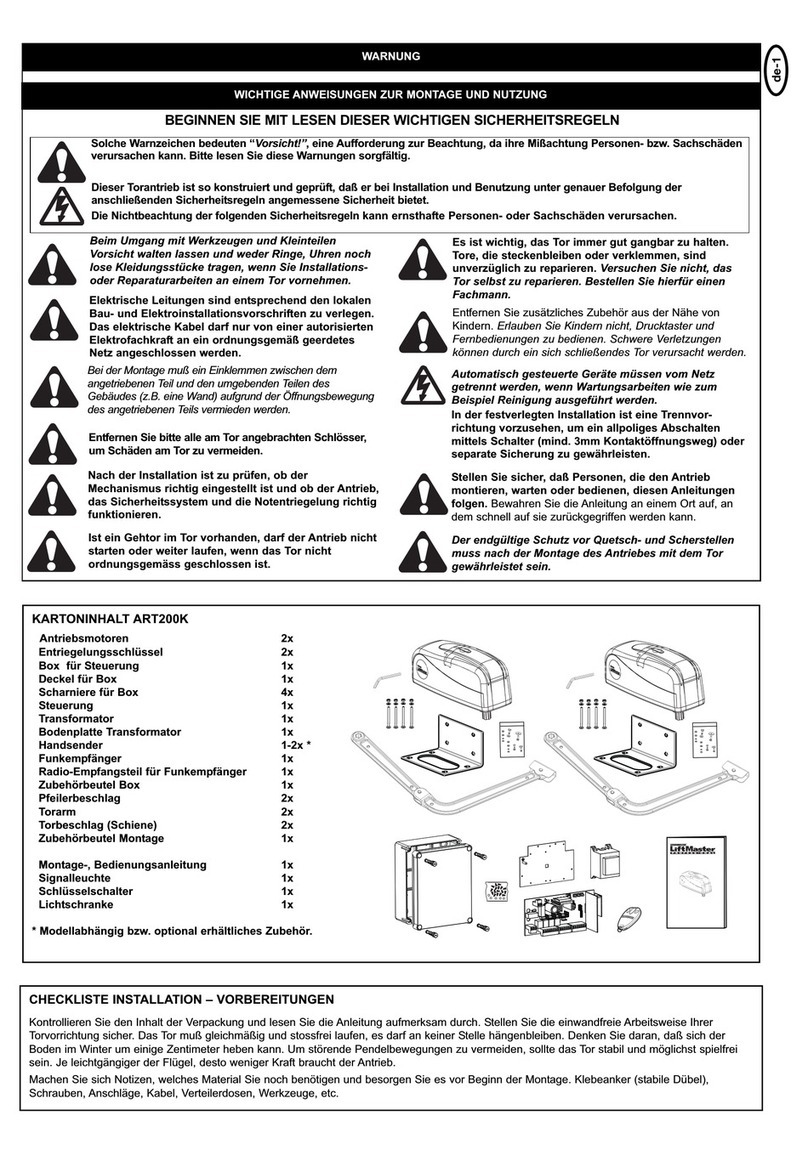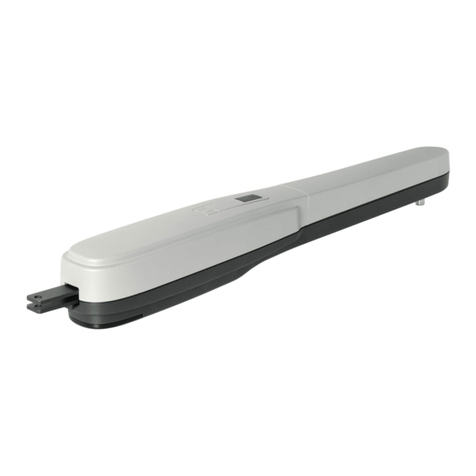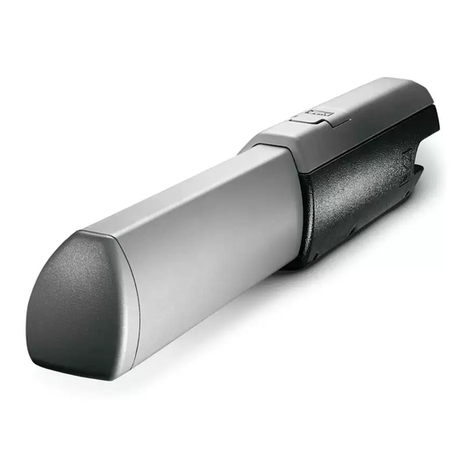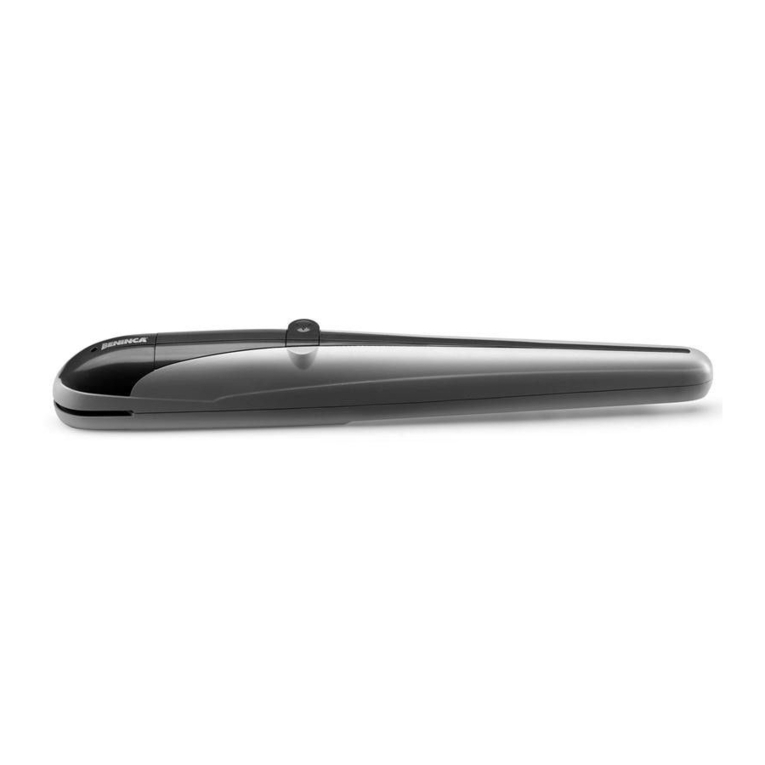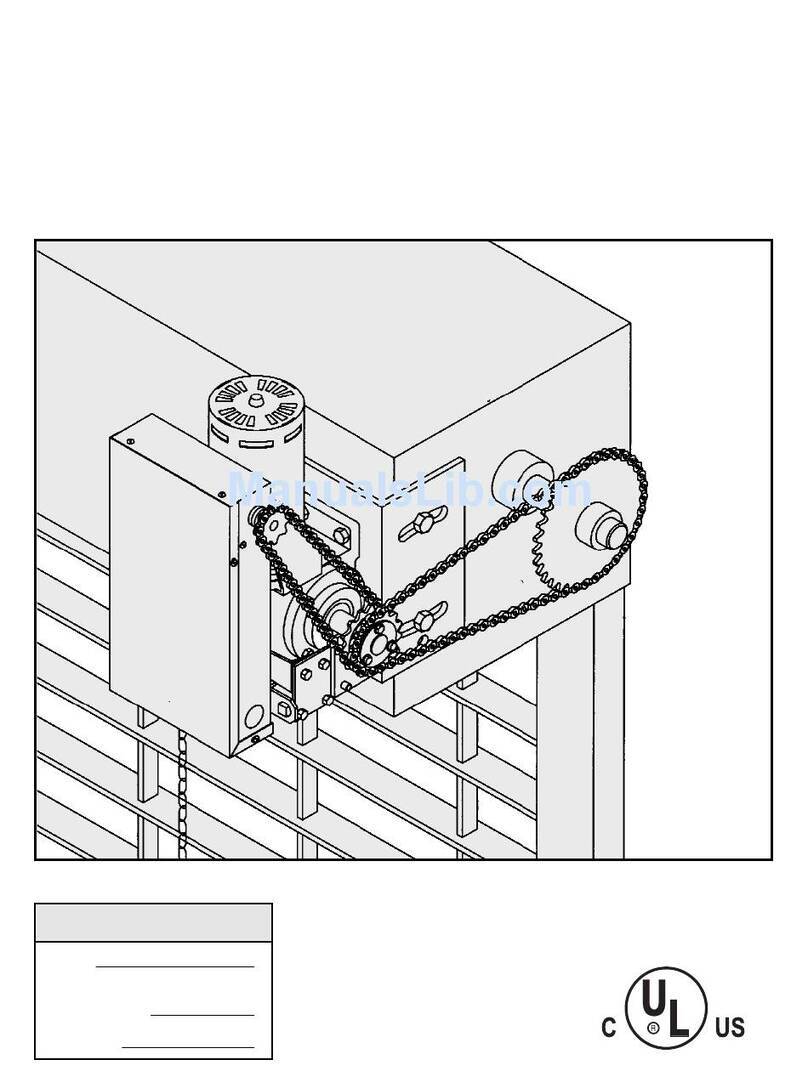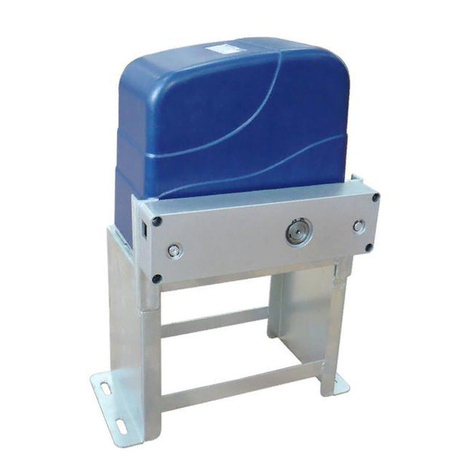Et DRIVE 1000 User manual

ET DRIVE1000 INSTALLER 2016.001.003
Installer Instrucons
High Trac 1000kg Slide Gate Operator
www.et.co.za

2
Introducon.
Page 3 Be Safe! Instrucons, warnings and obligaons.
Page 4 Technical specicaons.
Page 5 Component idencaon and descripons.
Site preparaon.
Page 6 Gate mechanics.
Page 7 Duty cycle.
Page 7 Motor posioning.
Page 8 Cabling requirements.
Hardware installaon - Mechanical.
Page 9 Baseplate kit and installing the baseplate.
Page 10 Cable conduit height above baseplate.
Page 10 Mounng the motor onto the baseplate.
Page 11 Decanng the oil into the gearbox.
Page 11 How to use the manual override.
Page 12 Installing the rack.
Hardware installaon - Electrical.
Page 14 Terminang the AC supply.
Page 15 Wiring and terminaon of the control card.
Page 16 Installing the limit actuator.
Control card programming and setup.
Page 17 Programming menu quick reference guide.
Page 18 Seng up the gate runme.
Page 19 Selecng a safety level.
Page 19 Safety infra-red beams setup.
Page 20 Selecng a BT operang mode and adjusng the BT auto-close me.
Page 21 Seng up the pedestrian open distance and pedestrian auto-close me.
Page 22 Receiver programming and setup.
Page 29 Advance programming opons and their denions.
Operang mode denions and examples.
Page 31 Collision sensing and safety overload rounes
Page 32 Safety infra-red beams funcon. All modes except P.I.R.A.C. auto-close mode.
Page 33 “BT” Buon triggers - Standard mode.
Page 34 “BT” Buon triggers - Simple auto-close mode.
Page 35 “BT” Buon triggers - Condominium auto-close mode.
Page 36 “BT” Buon triggers - P.I.R.A.C. auto-close mode.
Page 37 “PED” Pedestrian trigger. With no safety beams installed.
Page 38 “PED” Pedestrian trigger. With safety beams installed.
Page 39 “Loop” trigger.
Page 40 Auxiliary relay modes - Strike lock mode.
Page 41 Auxiliary relay modes - Magnec lock mode.
Page 42 Auxiliary relay modes - Courtesy light mode.
Page 43 Auxiliary relay modes - Receiver relay mode.
Page 44 Posive close mode.
Page 45 Holiday lock-out mode.
Page 46 Auto-close override/party mode.
Page 47 Tamper alarms.
Troubleshoong.
Page 48 Status LED, buzzer and diagnoscs menu denions.
Page 50 Troubleshoong guide and display denions.
Page 53 Warranty.
For any assistance with this product that is not covered in this manual please contact us on: 0860 109 238 (RSA) or via our online
support facility at www.et.co.za.

3
Be Safe!
WARNING!! These are the general safety obligaons for the installers and users of ET Systems
(Pty) Ltd automaon equipment. A copy of this document also appears in the user instrucons.
Those instrucons must be issued to the responsible end user during the handover and
instrucon meeng.
1. Only suitably qualied persons, may install, repair or service the product. Unless expressly indicated in the user instrucons, no
user serviceable components can be found inside any ET Systems (Pty) Ltd automaon product.
2. It is important for personal safety to study and follow all the instrucons carefully. Incorrect installaon or misuse may cause
serious personal harm.
3. Keep the instrucons in a safe place for future reference.
4. This product was designed and manufactured, strictly for the use indicated in the accompanying documentaon. Any other use
not expressly indicated in the documentaon, may damage the product and/or be a source of danger. ET Systems (Pty) Ltd cannot
accept responsibility for improper use or incorrect installaon of this product.
5. ET Systems (Pty) Ltd cannot accept responsibility if the principles of good workmanship are disregarded by the installer.
6. ET Systems (Pty) Ltd cannot accept responsibility regarding safety and correct operaon of the automaon, if other manufacturers’
equipment is added to this product.
7. Do not make any modicaons or alteraons to this product. Do not substute any component of this product with any other
component not expressly designed into this product.
8. Anything other than expressly provided for in the accompanying instrucons is not permied.
Prior to installaon:
1. All unnecessary ropes, chains and fasteners must be removed and all unnecessary latches or locks must be disabled from locking.
2. The gate or door must be balanced correctly where it, neither opens nor closes from any posion under its own load. When
operated by hand the gate or door should be free of hindrance and easily moved (In the case of a garage door if the balancing
springs need to be adjusted the adjustment should only be carried out by a qualied and experienced person).
3. The construcon of the gate or door must be sound and automatable. It is the responsibility of the installer to ensure that the
mechanical components of the gate or door system are sucient to withstand the necessary forces in cases of overload.
4. It is the responsibility of the installer to ensure the gate or door is suciently trapped within its range of travel by means of
mechanical ends of travel stoppers.
5. Ensure all xed mounng points, such as the wall above the door in a garage door system or the posts in a swing gate system, are
sound and strong enough to allow proper xing of the operator.
6. It is the responsibility of the installer to ensure the installed posion selected for this product, falls within the limitaons of the
products ingress protecon rang.
7. Ensure the area of installaon is not subject to explosive hazards. There should be no volale gasses or fumes as these can present
a serious safety hazard.
8. All ET Systems (Pty) Ltd garage door operators are supplied with a sealed 15A safety plug on lead for use in an electrical code
of pracce approved plug point. Do not extend, modify or replace the plug lead unless duly qualied as an electrician. Before
installing the unit, ensure the mains supply is switched o.
9. ET Systems (Pty) Ltd gate operators are supplied with a terminal connecon for the electrical supply beneath the screwed down
cover of the operator. In the case of a model requiring 220Vac supply at the operator, an all pole negavely biased switch, with a
contact opening of greater than 3mm must be installed within 1.5m of the operator. This switch must be clear of all workings of
the system and must be in a posion secure from public access. This switch and its connecons must be inspected and passed by
a cered electrician prior to using it.
10. It is the responsibility of the installer to ascertain that the designated persons (including children) intended to use the system,
do not suer reduced physical sensory or mental capabilies, or lack of experience and knowledge, unless they have been given
supervision or instrucon concerning the use of the system by a person responsible for their safety.
11. The drive may not be installed on a door incorporang a wicket door, unless the drive is disabled by the release of the wicket door.
(Wicket door :- A pedestrian door within the main gate or door)
1. Ensure the working area is clear of obstrucons and obstacles.
2. Install the safety warning scker within clear view of where the gate or door will be operated from. Typically this would be
adjacent to any xed trigger switches or on the gate or door itself.
3. The emergency manual release must be installed where it is no higher than 1.8m from the oor level. This would apply to the cord
in a garage installaon or the lockable lever in a gate installaon.
4. Any addional xed door control switches such as wall consoles or keypads, if installed, must be at a height of at least 1.5m, within
clear sight of the gate or door and away from any moving components of the system.
During installaon:
Connued overleaf.......

4
5. It is highly recommended that a set of safety infra-red beams be used in conjuncon with this product. The safety beams must be
installed in such a way that the product is prevented from running when anything is in the path of the door or gate.
6. Over and above the recommendaon to use safety infra-red beams with this product it is mandatory to install and use a safety
beam set when using the automac closing feature. It is recommended that a warning light be ed to any automaon system.
7. The gate or door warning labels must be installed in a prominent place and/or adjacent to any xed controls that trigger the
system. These must be in clear line of sight of the gate or door opening.
8. The emergency manual release instrucon label must be installed on or adjacent to the emergency manual release mechanism.
Aer installaon - It is the responsibility of the installer to ensure the users:
1. Is procient in the use of the manual emergency release mechanism.
2. Is issued with the documentaon accompanying this product.
3. Understands that the gate or door may not be operated out of clear sight.
4. Ensures that children are kept clear of the gate or door area at all mes, and that children do not play with the remote transmiers
or any xed trigger switches linked to the system.
5. Is instructed not to aempt to repair or adjust the automaon system and to be aware of the danger of connuing to use the
automaon system in an unsafe condion before a service provider aends to it.
6. Is procient in tesng the unit’s safety obstrucon sensing system.
7. Is aware of what to check for with regards to wear and tear that may need to be aended to from me to me by the service
provider.
8. Is aware that a fagued baery may not be disposed of in the general refuse and must be handed in at a baery merchant for safe
disposal. Before removing the baery from the system the household mains must be disconnected. In the case of the motor unit
being removed and scrapped, the baery must be removed rst.
TECHNICAL SPECIFICATIONS
Technical Data Low trac opon
Plug in transformer (Not included in kit)
High trac ACDC
Standard kit
Rated gate mass. 1000kg 1000kg
Maximum gate travel. 40m 40m
Primary power supply to gate. 29Vac @ 1A 50Hz – 60Hz 220 – 240Vac @ 50Hz – 60Hz
Peak power consumpon at gate. 30W 350W
Electrical class. Class 3 Class 1
Motor voltage. 24Vdc 24Vdc
Motor current. Current limited to 13A. Current limited to 13A.
Duty cycle maximum.
See determining your duty cycle on PG (7) 25% with 220Vac present 98% with 220Vac present
Number of operaons on baery reserve.
(Baery health and charge level at me of
power failure dependent. Calcuted on a 5m
gate with rolling resistance of <15kgf)
100 using the standard 5Ah baery.
This can be upgraded to 150 by installing 2 x
3.5Ah baeries.
100 using the standard 5Ah baery.
This can be upgraded to 150 by installing 2 x
3.5Ah baeries.
Gate speed
At rolling resistance of <15kgf Up to 28m/min. Can be adjusted down. Up to 28m/min. Can be adjusted down.
Rated Load 600N 600N
Operang temperature range -10 to 50° C (14F to 122F) -10 to 50° C (14F to 122F)
An-crushing safety sensing Yes – Electronic gate proling Yes – Electronic gate proling
Auxiliary supply output 12Vdc @ 400mA 12Vdc @ 400mA
Built in baery charger. Mulple stage auto-calibrang 500mA Mulple stage auto-calibrang 500mA
Receiver format ET BLU MIX © backward compable with ET
BLUE (Rolling code)
ET BLU MIX © backward compable with ET
BLUE (Rolling code)
Receiver frequency 433.92MHz 433.92MHz
Receiver channels 4CH (BT, PED, Aux relay, Holiday lock-out) 4CH (BT, PED, Aux relay, Holiday lock-out)
Receiver memory capacity 1023 users 1023 users
All users can be allowed control of all channels Yes Yes
Ingress protecon IPX4 IPX4
Physical dimensions See next page. See next page.
Technical specicaons.

5
12
3
4
5
15
14
13
12
10
9
6
7
8
7
6
18
6
7
8
7
6
17
17
16
15
11
Component idencaon and descripons.
Diagram
number Descripon Diagram
number Descripon
1Control card 10 Baseplate
2Dashboard 11 ACDC power pack 220Vac input
3Plug-in terminal connectors 12 Manual override access hatch
4ACDC power pack 13 Manual override access hatch lock
5Baery 14 Electric motor
6Levelling and height adjusng bolts 15 Electric motor brush ports
7Mounng bolts and nuts 16 Revoluon counter ring magnet
8Security bracket kit mounng point 17 Ends of travel limits, reed switches
9Cable inlets 18 Output drive pinion
359
410
237
0 - 10mm
355
364
92.5
16
305

6
BEFORE ATTEMPTING TO INSTALL A SLIDE GATE OPERATOR, PLEASE BE CERTAIN YOU HAVE
READ AND UNDERSTOOD THE FOLLOWING TO ENSURE CONTINUED SATISFACTORY SAFE
SERVICE FROM THIS PRODUCT:
1. Gate mechanics.
2. Duty cycle.
3. Where to posion the gate motor with regards to ingress protecon.
4. Cabling requirements.
Gate mechanics.
Gate Leaf:
Gate leaf must be sound and of sucient construcon to accommodate an operator of this type (see technical specicaons).
Gate leaf should be straight and true with minimal deviaon to the fascia that the rack must aach to (no ‘banana-eect’).
Wheels and Track:
The track must be secure, straight, level and free of all obstrucons.
Recommended wheel type and size for this automaon is steel or steel alloy, machined or cast wheels of at least 100mm diameter using sealed roller
bearings. The larger the wheel the less rolling resistance generated. Larger wheels also maintain their plumb and momentum longer. When wheels
are xed in the gate, and not able to pivot, binding can occur if the gate is bowed. (Banana eect) For wheel prole and matching track types, see the
three examples below:
Recommended Less problemac Problemac
Guides:
• It is recommended that a roller guide consisng of a sealed roller bearing clad in nylon be used.
• The guidance system should be installed at the top edge of the gate whenever possible. In cases where this is not possible the guidance system
should never be below the halfway point of the total gate height when the gate is in posion on its track.
• In the case of a single guide roller running in a guide channel, ensure the guide never touches both inside walls of the channel simultaneously. This
causes the roller to snag as it tries to roll in both direcons at once.
• In the case of 2 guide rollers being used on either side of the gate leaf, ensure that both wheels never touch the leaf simultaneously.
• Avoid using more than 1 guide roller on the same side of the gate leaf to prevent binding.
• As with the wheels the larger the guide the less rolling resistance generated.
Gate Travel:
Using a sherman’s pull scale, as shown below, pull the gate fully open and fully closed at approximately the same speed as the operator you intend to
use (see technical specicaons). For opmum performance, ensure that the maximum resistance does not exceed 40kgf starng and 30kgf running.
The starng resistance should fall away within 300 to 500mm. Note the recommended track, wheel and guide types menoned b) and c) above.
NB! Install physical stoppers at the ends of the gate travel to prevent the gate over-running the ends of the track as shown here. (Naonal safety
standard requirement)
End of travel stopper!
End of travel stopper!

7
Duty cycle.
The Formula used to determine duty cycle is:
Run me x 100 = Duty cycle
Run me + rest me
Working example 1: (Low duty cycle)
Run me: 17 seconds.
Rest me: 20 seconds.
17 ÷ 37 x 100 = 45.94
Thus the duty cycle in example 1 is said to be 45.94%
Working example 2: (High duty cycle)
Run me: 17 seconds.
Rest me: 1 second.
17 ÷ 18 x 100 = 94.44
Thus the duty cycle in example 2 is said to be 94.44%
The above examples do not factor in resistance and gate mass. These two elements contribute greatly to the amount of heat generated in your gate
automaon system.
Below are the maximum allowed duty cycles based on the gate mass and rolling resistance for the ET motor models. These are calculated to conform
to the standards set out in the SANS 60335-95-1:2011 safety code.
Duty cycle capabilies guideline of the ET Drive series motor models:
Model Gate Mass Starng Resistance Rolling Resistance Max Duty Cycle
Drive 1000 -
ACDC opon ≤ 1000 kg ≤ 40 kgf ≤ 30 kgf 98%
Drive 1000 -
Baery dependent opon. ≤ 1000 kg ≤ 40 kgf ≤ 30 kgf 25%
Where to posion the gate motor.
Liquid ingress:
The ET Drive series motor models all carry an ingress protecon rang of IPX4. This means they are protected from splashing water. They are not
water ght as there are sensive electronic and electrical circuits that require uninhibited airow to remain cool and dry.
When deciding on an installaon posion, be aware of water collecon points around and near the desired mounng posion of the motor unit. If
the water does not ow away quick enough, it can seep into the system and cause expensive and possibly hazardous damage. Always install the unit
higher than the highest level, any water owing past the motor unit can reach.
Physical protecon:
Whenever possible, always install the gate motor on the opposite side of the gate’s guide/emergency post, to the driveway itself. This way it is out of
the path of the motor vehicles as they pass through the entrance/exit.

8
Cabling requirements.
• Before mounng the operator ensure your cables and conduing are in place to prevent any inconvenience at a later stage.
• All 220Vac mains cabling and circuits need to be installed by a qualied electrician and signed o by a registered electrician.
• Allow for spare cabling in case of faulty cable & breakages (especially important when using low specicaon cable).
• As automaon systems vibrate when in use, it is highly recommended that only mul-stranded, exible cables be used.
• If installing an intercom, remember to allow for sucient cable cores for all the users of the system as per manufacturers cabling requirements.
• The Drive 1000 motor is designed to facilitate three 20mm conduits going directly into its housing from below. If more cabling needs to be routed
to the motor, we suggest that a weatherproof electrical box be installed as a distribuon box. All of the circuits can then be extended to the
distribuon box and terminated there.
1
29V
3
Alarm
panel
2
11 4
10
8
9
1
6
5
7
1. Courtesy lights twin + earth 1.0mm back to motor housing and
isolator switch.
7. Free exit loop 1.5mm silicone insulated single core exible stranded
cable back to loop detector that is typically installed in the motor
housing.
2. Intercom gate staon (check with intercom supplier for cable
specicaons)
8. From intercom internal equipment (check with intercom supplier
for specicaons) + 5 cores 0,5mm stranded for status LED, BT and
Pedestrian triggers.
3. ACDC model (220Vac) - twin + earth: 2.5mm stranded (An all pole
negavely biased isolator must be installed within 1,5m of the
motor unit, in circuit with the 220Vac supply)
9. Alarm monitoring circuit. 2 cores 0.5mm stranded back to motor
housing.
4. Safety infra-red beam RX power & switch. 4 cores 0,5mm stranded
back to motor housing.
10. Oponal plug in transformer for low trac sites (29Vac) - twin +
earth. Min 0,5mm stranded (1Amp)
5. Safety infra-red beam TX power. 2 cores 0.5mm stranded back to
motor housing.
11. Lock power supply. Twin + earth 2.5mm stranded from isolator
switch.
6. Electric lock power. 2 cores 0,5mm stranded back to independent
lock power supply via motor housing.

9
Baseplate and fastener kit assembly.
2
1
1
3
2
32
3
2
3
3
4
5
3
4
5
6
7
Diagram
number Descripon
1Custom cup bolts for fastening
the gearbox to the baseplate.
2M10 Nylock nuts.
3M10 Flat washers.
4M10 Machine nuts.
5M10 J-Bolts for concrete casng
method.
6Cabling conduit piping.
7Baseplate.
Installing the baseplate.
There are a number of dierent fastening techniques that can be used to fasten the baseplate in posion. The standard kit is supplied with J-bolts
so that the baseplate can be cast in concrete. While this method oers a nice solid base it takes more than 48hrs to install as the concrete must cure
properly before connuing with the installaon. Whichever mounng method you opt for, the posion of the base plate will always remain the same.
Here are the dimensions to use when posioning the base plate. The baseplate should be installed above the highest point of ooding that may occur
with the run o of water down the driveway.
Proudest component of
the gate on the motor side
Edge of the baseplate
nearest to the gate
Required space
30 - 50mm
Gate positioned where the proudest component
is opposite the base plate of the operator.
Base plate positioned on the opposite
side of the gate guide/emergency post,
to the driveway.
Gate guide/
emergency post
PLAN VIEW OF THE BASEPLATE INSTALLED
Driveway
Required space
> 50mm to allow for
the optional security
bracket.
Cable inlet.

10
Cabling conduits height:
The cabling conduits should protrude more than 10mm above the top surface of the baseplate to aord beer weather proong. To avoid them
snagging on the boom of the gearbox when the gearbox posion is adjusted backward and forward, and to allow sucient space for the cables to be
routed into the motor housing, they should not protrude more than 30mm.
10 - 30mm
Mounng the operator onto the baseplate.
Removing the cover:
The cover is secured in place by means of two screws and a pair of locking tabs on the manual override hatch.
11
Using a Phillips® screwdriver remove the
two cover screws.
2
Unlock and open the manual override
hatch.
3
Li the main cover to remove it.
Mounng the gearbox: (You will need a 13mm socket or spanner and a 5mm Allen® hex key)
The gearbox is fastened onto the baseplate by means of the 4x M8 Custom cup bolts, square washers and M8 Nylock nuts. The gearbox distance from
the gate can be adjusted backwards and forwards by up to 30mm. Remember to ensure that there is enough space allowed between the fascia of the
pinion and the proudest part of the gate that passes the pinion. This is to prevent any part of the gate snagging on the pinion as the gate runs.
Before ghtening the gearbox down on the baseplate, ensure you have le approximately 5mm between the baseplate and the boom of the gear-
box. This will allow for adjustment of the rack to pinion spacing later on.
8 - 10mm
Side view.

11
Decanng the oil into the gearbox.
Oil ller port Oil ller port
Remove oil ller port plug. Decant all 100ml of the 80W90 oil into the
gearbox.
Replace oil ller port plug.
How to use the manual override.
Move gate open and closed by hand.
1
2
4
3
5
78
910
11
6
NB! The gearbox can be le in manual mode with the manual override hatch closed and locked up.
To disengage the gearbox (Manual mode)
1. Raise lock cover.
2. Insert the key.
3. Turn the key clockwise.
4. Open the manual override hatch.
5. Swing manual override lever to the right.
6. Manoeuvre the gate by hand.
To re-engage the gearbox (Normal mode)
7. Swing the manual override lever to the le.
8. Close the manual override hatch.
9. Turn the key counter clockwise.
10. Lower the lock cover.
11. Ensure the gearing is engage by pushing or
pulling the gate unl the gearing “clicks” in.

12
Installing the rack.
Correct Too loose Too tight
Rack to pinion spacing.
Correct.
The driving surfaces of each tooth are 1 to 2mm
apart. Allowing for slight variance in the height
of the rack when the wheels shrink in colder
condions or where the gate exes and the rack
is no longer square to the pinion.
Incorrect!
This will cause skipping of teeth at the slightest
resistance to the gate travel, resulng in the
motor control going out of synchronizaon to
the gate posion. The long term damage here
will be stripped teeth.
Incorrect!
This will cause unwanted rolling resistance
especially in colder condions. Where the wheel
shrinkage will cause the gate to sit heavier on
the pinion or when the rack is no longer square
to the pinion due to gate ex. (False safety
sensing acvaon)
The following shows a simple method of installing a rack that ensures you achieve the correct t between the rack and pinion.
Rack resting on
pinion
Rack clamped
to end of gate
Spirit level
• Begin by double checking you have adjusted the height adjusng bolts so that there is
about 5mm between the gearbox base and the baseplate.
• Clamp the end of the rst length of rack’s end to the closing edge of the gate.
• Rest the other end of the length on the pinion as shown here.
• Use a spirit level to ensure the rack remains true.
• If sased with the rack level fasten the rst “TEK” screw (supplied) in
the middle of the slot nearest the closing edge of the gate.

13
3 -4mm
Turn each height adjusting bolt 1 full turn
counter clockwise to lower gearbox evenly
by approximately 1 - 2mm.
Tighten down each Nylock
nut when nished with the
height adjusting bolts.
“TEK” screw installed through
the rack and into the gate to
lock the rack in position.
• Move the gate towards the open posion. Far enough that you can access the last mounng slot at the opposite end of the length of rack to
the end already fastened. Fasten the next “TEK” screw here while the rack sll rests atop the pinion.
• To install addional lengths of rack, move gate closed unl the next length of rack meets the rst length and the opposite end once again rests
on the pinion.
• To ensure the 2 lengths of rack marry correctly use an o cut of rack clamped upside down across the join of the 2 lengths.
• Connue to fasten the “TEK” screws as before
• When nished installing sucient rack to allow for the full travel of the gate plus enough to allow for the limit actuator (as shown in the next
secon) lower the gearbox by turning each height adjusng screw 1 full turn counter clockwise.
• Test the meshing of the rack and pinion. (See pictures of rack to pinion spacing on previous page).
• If sased fasten a “TEK” screw directly through both the rack angle and the gate so that you have 5 “TEK” screws per length of rack evenly
spaced.

14
Electrical and electronic installaon and setup.
As a gate motor vibrates when in use, it is strongly recommended that only mulple strand exible cables be used.
Before closing the unit, always remember to double check that all connecons are securely made, that there are no stray strands aring out that can
short circuit against other adjacent connecons or bared wires and that no cables will be pulled loose when the cover is replaced on the unit.
Double check the baery connecons as loose connecons can cause arcing and corrosion of the baery terminals.
Terminang the AC voltages:
Please note the input voltages can dier but the control card, is the same for all the models.
The ACDC power supply requires 220Vac at the gate motor. This 220Vac must be circuited through a weatherproof all pole isolator switch. This isolator
switch must be installed within 1,5m of the unit, must not be installed within the workings of the system (the gate may not pass in front of it) and
must be posioned so that it cannot be tampered with for the outside of the property. This circuit must be cered by way of a C.O.C. (cercate of
compliance) by a registered electrician.
In the case of the plug-in transformer being used, where the low voltage 29Vac is run to the gate, there is no need for the all pole isolator at the gate and
the circuit does not need to be cered by a registered electrician*. The cable however must sll be installed in its own dedicated conduit pipe and the
basic principles of electrical safety standards should sll be followed when selecng, working with and installing the cable for this circuit.
* Some municipalies may require cercaon of all domesc electrical circuits including those below 50V.
The following shows the wiring of the 220Vac to the ACDC power supply and how to access the 2A fast blow 20mm x 5mm fuse located within the power
supply module.
Connecng the 220Vac supply to the ACDC power supply:
O On
Live 230VAC
Earth
Neutral 230VAC
VAC input LED indication O On
Ensure the 220Vac has been isolated. Terminate the 220Vac and earth as shown here. Switch the 220Vac back on.
O On 5 Amp fast blow 230V fuse. O On
Ensure the 220Vac has been isolated. Replace the 2A 220Vac fuse here. Switch the 220Vac back on.
Accessing the 220VAC 2A fuse in the ACDC power supply in the case of a burnt out fuse:
2A 220Vac fast blow
fuse
Vac input LED indicator
220Vac live.
Earth.
220Vac neutral.

15
RELEASE
LIMIT L
LIMIT R
BLUEBUS
BT
PED
LOOP
BM
BM C
STATUS
ALRM
+12V
GND
AC
EARTH
AC
GND
PSU
BAT 1
BAT 2
N/O
COM
N/C
MOT+
MOT -
GND
ACT
RF
29Vac
@ 1A 230Vac
Earth
ACDC
PSU 230Vac34Vdc @ 12A
BLK Motor
12Vdc @400mA peak for ancillary devices
like safety beams and loop detectors.
}
Com
N/C
N/O
Relay installed to allow
for the triggering of a
siren or security light or even
a zone on an alarm panel.
12Vdc
15A Motor fuse.
2A Auxiliary relay fuse.
BLU
Com
N/C
N/O
100Ω
Safety beam
RX
Com
N/CN/O
N/O N/O Loop
detector
Non-polarity sensive terminaon for 2 wire
Bluebus devices. For example safety beams.
}
-
+
-
+
24V
5Ah
Baery
Standard in kit.
Oponal.
-
+24V 3.5Ah
Baery
-
+24V 3.5Ah
Baery
From manual override monitoring switch.
From lehand side limit switch.
From righthand side limit switch.
Oponal low voltage and low current plug in
transformer terminaon. For use in low
traffic applicaons only.
Auxiliary relay for use either in courtesy light circuit or, in an electric lock circuit
or as a single channel receiver. For examples of lock or courtesy light circuits see
next page.
Wiring and terminaon of the control card.

16
Installing the limit actuator.
RELEASE
LIMIT L
LIMIT R
BLUEBUS
BT
GND
This diagram depicts how to install the limit actuator.
1. Push the gate up against the closed stopper.
2. Remove the rack screw (holding the nylon teeth to the steel angle) closest to being in line with the limit switch. Or in the case of steel rack, weld a
M4 x 20 machine bolt upside down on top of the spine of the rack in line with the limit switch.
3. Fasten the actuator down onto the rack using either the M4 x 20mm self-tapping screw supplied with the kit or with a nut in the case of steel rack.
4. Adjust the actuator so that it is approximately halfway across the limit switch.
5. Move the gate open and then closed again. Ensure the limit LED comes on before the gate impacts with the closed stopper. Posive closed mode
will always close the gate the last 50mm if selected in programming.

17
Using the control card display and dashboard.
The Drive 1000 is equipped with a LCD display and interacve keys for simplied programming and diagnoscs. All setup, of the various features,
requires that the control card dashboard be used. Below are the funcons of each key on the dashboard.
ACT
RF
Navigate backward in menus, decrease
values, indicate lehand closing gate
in runme setup funcon or enter
diagnoscs menu while in standby.
Exit menu levels without saving.
Radio acvity indicator. Processor acvity indicator.
Navigate forward in menus, increase
values, indicate righthand closing gate
in runme setup funcon or enter
diagnoscs menu while in standby.
Test BT mode when in standby or exit
all the way back to standby without
saving when in programming.
Enter programming, advance to next
level of opon on display, save value
on display.
Control card programming and setup.
1. Runme setup. - Page 18.
2. Collision force sensing. Safety level setup. - Page 19.
3. Safety beam setup. - Page 19.
4. BT triggers operang mode selecon and setup. - Page 20.
5. Pedestrian operaon setup. - Page 21.
6. Receiver setup.
a. Learn remotes. - Pages 22, 23 and 24.
b. Erase remotes. - Pages 25 and 26.
c. Diagnose remotes. - Page 27.
d. Receiver informaon. - Page 28.
7. Advanced menu. - Pages 29 and 30.
a. Crawl distance.
b. Quick stop distance.
c. Gate speed.
d. Posive close mode.
e. Auxiliary relay setup.
f. Blue BUS setup.
g. Power sengs.
h. Controller setup.
i. Controller informaon.
j. IEC Standards mode. Enable/disable. (Safety beams must be installed and congured before you can enable this mode)
k. Reset and restore.
Programming menu quick reference guide:

18
Runme Setup Seng up the gate runme. (Mandatory)
From Standby status
- Standard mode -
- Standby
Before connuing with the runme setup ensure the limit actuator has
been installed correctly as per page 16 in this manual. Begin with the
gate midway in its travel.
NB. To speed up the gate while running during this procedure, press and hold
either the < or > buons.
Acon Response
Descripon Display Buzzer Gate
To enter the program
menu. Press and hold the
buon unl buzzer
beeps.
Display and buzzer
conrms.
Programming menu
<or> for opons
Scroll < or > to select the
runme setup opon.
Display scrolls
through opons.
Runme setup
<Limits NOT set>
Press and release the
buon to select runme
setup.
Display asks you to
conrm the gate is
engaged midway in
travel.
Move gate midway
then press
Press and release the
buon to conrm the gate
is midway.
Display asks you to
select the gate closing
direcon.
Set Close Direct
Press < or >
Conrm gate closing
direcon by pressing and
releasing either the < or >
buon.
Gate closes slowly.
Display and buzzer
conrms.
Finding closed
limit
When the closed posion
is reached and the closed
limit is triggered. LED on.
Gate stops and starts
opening.Display
prompts you to stop
the gate in the open
posion.
Learning length
Press at open
Press and release the
buon to stop the gate
at the required open
posion.
Gate stops opening.
Display asks you to
ne tune the open
posion if required
and then conrm the
posion.
Fine Adjust <or>
Then press
Press and release the
buon to save the
required open posion.
Gate closes slowly.
Display and buzzer
conrms.
Verifying length
When the closed posion
is reached and the closed
limit is triggered. LED on.
Gate stops. Display
and buzzer warn the
proling is about to
begin.
WARNING!
Proling.
Once warning tone has
stopped.
Gate begins running
open at full speed.
Display conrms.
Opening.
Proling.
When the previously
programmed open
posion is reached.
Gate stops and
begins closing again
at full speed. Display
conrms.
Closing.
Proling.
When the closed posion
is reached and the closed
limit is triggered. LED on.
Gate stops. Display
and buzzer conrms.
Runme setup.
<Limits set>
x2
x1 STOP
x1 STOP
x1
RELEASE
LIMIT L
LIMIT R
BLUEBUS
BT
GND
x1
x1
RELEASE
LIMIT L
LIMIT R
BLUEBUS
BT
GND
x1
RELEASE
LIMIT L
LIMIT R
BLUEBUS
BT
GND
x1
Scroll le or right to next
program opon. OR
“Selected” mode
- Standby
EXIT back to standby
status

19
Selecng a safety level. Overload Seng
From Standby status
- “Selected” mode -
- Standby
This adjusts the force level, over and above the nominal gate
resistance, needed to trigger the safety overload rounes.
Level 1 being the most sensive and 8 being the least sensi-
ve. The factory default is level 3.
Acon Response
Descripon Display Buzzer Gate
To enter the program menu.
Press and hold the buon
unl buzzer beeps.
Display and buzzer
conrms.
Programming menu
<or> for opons
Scroll < or > to select the
runme setup opon.
Display scrolls
through opons.
Overload Seng
< = change >
With “Overload Seng” on
the display, press and release
.
Display shows current
opon status.
Overload Seng
< >
Scroll < or > to the required
seng.
Display changes
respecvely.
Overload Seng
< >
With required seng
displayed, press and release
.
Display briey shows
the new seng is
saved.
Overload Seng
Saved = 2
Aer display conrms new
seng.
Overload Seng
< = change >
Display returns to
programming menu
opons list.
Overload Seng
< = change >
x2
x1
x1
Scroll le or right to next
program opon. OR “Selected” mode
- Standby
EXIT back to standby
status
x2
Safety infra-red beams setup. Beam Setup.
From Standby status
- “Selected” mode -
- Standby Use this opon to enable the safety beam circuit for use in
standard BT mode. (See page 20)
Acon Response
Descripon Display Buzzer Gate
To enter the program menu.
Press and hold the buon
unl buzzer beeps.
Display and buzzer
conrms.
Programming menu
<or> for opons
Scroll < or > to select the
beam setup opon.
Display scrolls
through opons.
Beam Setup
< = change >
With “Beam Setup” on the
display, press and release .
Display shows current
opon status.
Beam Setup
Disabled
Scroll < or > to toggle
between “Enabled” and
“Disabled”.
Display changes
respecvely.
Beam Setup
Enabled
With required seng
displayed, press and release
.
Display briey shows
the new seng is
saved.
Beam Setup
Enabled Saved
Aer display conrms new
seng.
Beam Setup
Enabled Saved
Display returns to
programming menu
opons list.
Beam Setup
< = change >
x2
x1
x1
Scroll le or right to next
program opon. OR “Selected” mode
- Standby
EXIT back to standby
status
x2

20
BT Mode Seng Selecng a BT operang mode and adjusng the BT auto-close me.
From Standby status
- “Selected” mode -
- Standby
The factory default is standard 4 step mode.
The factory default auto-close me is 15 seconds. The mer range is
1 – 254 seconds. PLEASE NOTE!! If any trigger opon, that makes use
of an automac closing mer, is used then the infra-red safety beams
input becomes acve for that transacon. A set of safety infra-red
beams must be installed using the technique indicated in this manu-
al to allow for gate closing. The safety beam funcon on this control
card conforms to the CE safety standards.
Acon Response
Descripon Display Buzzer Gate
To enter the program menu.
Press and hold the buon
unl buzzer beeps.
Display and buzzer
conrms.
Programming menu
<or> for opons
Scroll < or > to select the
beam setup opon.
Display scrolls
through opons.
BT Mode Seng
< = change >
With “BT Mode Seng”
on the display, press and
release .
Display shows current
opon status.
BT Mode Seng
< Standard >
Scroll < or > to the required
BT mode opon.
Display changes
respecvely.
BT Mode Seng
< Standard >
BT Mode Seng
< Auto-close >
BT Mode Seng
< CONDO >
BT Mode Seng
< P.I.R.A.C. >
With required seng
displayed, press and release
.
If Standard mode was
selected, the display
and buzzer will
conrm the seng
is saved. Display
then reverts to
programming opons
list.
BT Mode Seng
Standard - Saved
If Auto-close, CONDO
or P.I.R.A.C. were
selected, then the
buzzer beeps once,
and the display
prompts you to select
the required auto-
close me.
Set Auto-close
me = 15s
Scroll < or > to the required
seng.
Display changes
respecvely.
Set Auto-close
me = 20s
With required seng
displayed, press and release
.
Display briey shows
the new seng is
saved.
Set Auto-close
Saved = 20s
Aer display conrms new
seng.
Set Auto-close
Saved = 15s
Display returns to
programming menu
opons list.
BT Mode Seng
< = change >
x2
x1
x1
Scroll le or right to next
program opon. OR “Selected” mode
- Standby
EXIT back to standby
status
x2
x1
x2
Table of contents
Other Et Gate Opener manuals
